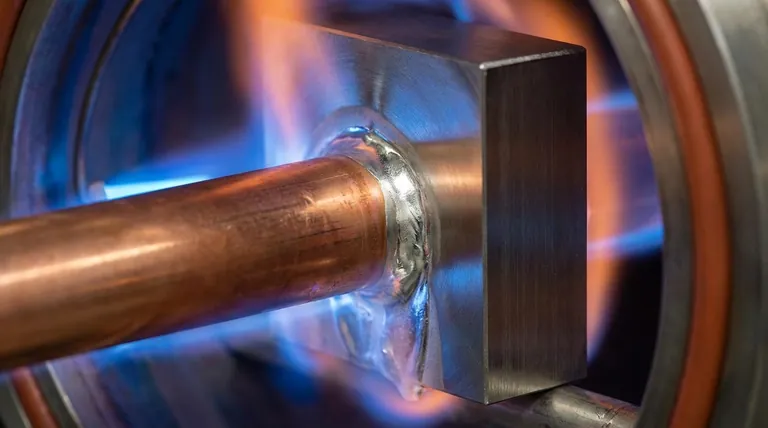네, 두 가지 다른 금속을 브레이징하는 것은 절대적으로 가능합니다. 사실, 이종 재료를 접합하는 것은 브레이징 공정의 주요 강점 중 하나입니다. 이 방법은 강철, 구리, 니켈, 알루미늄, 심지어 세라믹을 포함한 다양한 금속을 접합할 수 있게 해주며, 접합할 두 모재보다 낮은 온도에서 녹는 충전 금속을 사용합니다.
핵심 원리는 간단합니다. 거의 모든 두 금속을 브레이징할 수 있지만, 접합부의 성공은 충전 금속이 양쪽 표면에 "젖어" 결합하는 능력에 전적으로 달려 있으며, 이 과정은 세심한 세척과 표면 산화물 제어를 필요로 합니다.

기본 원리: "젖음성"
브레이징은 모세관 현상에 의해 작동하며, 용융된 충전 금속이 두 모재 사이의 좁은 틈으로 빨려 들어갑니다. 이를 위해서는 충전재가 표면을 "적실" 수 있어야 합니다.
젖음성이란?
젖음성은 물이 깨끗한 유리판에 퍼지는 방식과 왁스칠된 자동차에 물방울이 맺히는 방식을 생각하면 됩니다. 강한 브레이징 접합부를 위해서는 용융된 충전 금속이 두 모재 표면에 매끄럽게 퍼져 완전히 부착되어야 합니다.
표면 산화물의 역할
거의 모든 금속은 공기에 노출되면 눈에 보이지 않는 산화물 층을 형성합니다. 이 산화물 층은 장벽 역할을 하여 충전 금속이 모재와 직접 접촉하는 것을 방해하고 젖음성을 방해합니다.
산화물 장벽 극복
성공적인 브레이징을 위해서는 이 산화물 층을 제거하고 가열 과정 중에 다시 형성되는 것을 방지해야 합니다. 이는 주로 두 가지 방법으로 달성됩니다.
- 플럭스: 가열 전에 접합 부위에 도포하는 화학 화합물. 플럭스는 녹아서 산화물을 용해하고 접합부를 대기로부터 보호합니다.
- 제어된 분위기: 브레이징은 특정 가스(예: 수소)로 채워진 용광로 내부 또는 진공 상태에서 수행됩니다. 이 분위기는 화학적으로 산화물을 제거하거나 애초에 형성되는 것을 방지합니다.
일반적인 이종 금속 조합
브레이징은 매우 다재다능하지만, 일부 조합은 다른 조합보다 더 간단합니다.
강철, 구리 및 니켈 합금
이러한 재료는 서로 성공적으로 브레이징되는 경우가 많습니다. 산화물이 비교적 관리하기 쉽고, 많은 표준 충전 금속(종종 은 또는 구리 기반 합금)이 이들과 호환됩니다.
알루미늄의 과제
알루미늄은 티타늄, 니켈, 베릴륨과 같은 다른 금속에 브레이징할 수 있습니다. 그러나 강력한 산화물 층과 낮은 융점으로 인해 특수 플럭스와 정밀한 온도 제어가 필요합니다.
특히, 알루미늄은 표준 기술을 사용하여 구리나 황동에 직접 브레이징할 수 없습니다. 이러한 조합은 니켈과 같이 더 호환되는 재료로 금속 중 하나를 사전 도금하는 것과 같은 특별한 조치를 필요로 합니다.
고급 재료: 세라믹 및 내화 금속
브레이징의 원리는 비금속에도 적용됩니다. 세라믹은 금속에 브레이징할 수 있으며, 충전 합금이 양쪽 표면을 적실 수 있다면 가능합니다. 내화 금속(예: 텅스텐)은 오염을 방지하기 위해 특수 진공 브레이징 기술을 사용하여 반응성 금속(예: 티타늄)에 접합되는 경우가 많습니다.
주요 고려 사항 이해
두 가지 다른 금속을 접합하는 것은 안정적인 접합부를 위해 관리해야 할 복잡성을 야기합니다.
충전 금속 호환성
충전 금속은 두 재료 사이의 다리 역할을 합니다. 용융점은 공정 중에 두 모재가 녹지 않도록 두 모재보다 낮아야 합니다. 또한 강력한 야금학적 결합을 형성하기 위해 두 재료와 화학적으로 호환되어야 합니다.
열팽창 관리
다른 재료는 가열 및 냉각 시 다른 속도로 팽창하고 수축합니다. 이 차이(열팽창 계수)가 상당하면 냉각 시 접합부에 엄청난 응력을 발생시켜 균열이나 파손을 유발할 수 있습니다. 이는 공정 설계 및 가열/냉각 속도를 통해 관리해야 합니다.
갈바닉 부식 방지
두 이종 금속이 전해질(예: 습기)이 있는 환경에서 접촉하면 갈바닉 전지를 형성하여 한 금속이 빠르게 부식될 수 있습니다. 충전 금속의 선택은 이 효과에 영향을 미칠 수 있으므로 특정 환경에서 장기 서비스용 부품에 대한 중요한 고려 사항입니다.
목표에 맞는 올바른 선택
접합해야 하는 재료와 필요한 성능에 따라 접근 방식이 전적으로 달라집니다.
- 주요 초점이 일반적인 제작(예: 강철-구리)인 경우: 표준 은 기반 충전 금속과 화학 플럭스로도 강력한 결합을 얻기에 충분합니다.
- 주요 초점이 반응성 금속 접합(예: 알루미늄-티타늄)인 경우: 알루미늄용으로 설계된 특수 플럭스 또는 제어된 분위기 용광로와 호환되는 충전 합금이 필요합니다.
- 주요 초점이 고성능 응용 분야(예: 내화 금속)인 경우: 이러한 까다로운 접합부는 순도와 접합 무결성을 보장하기 위해 거의 항상 특수 진공 용광로 브레이징이 필요합니다.
이러한 핵심 원리를 이해함으로써 다양한 재료 간에 강력하고 안정적인 접합부를 만들기 위해 브레이징을 자신 있게 사용할 수 있습니다.
요약표:
| 주요 고려 사항 | 이종 금속에 중요한 이유 |
|---|---|
| 충전 금속 젖음성 | 강력한 접합부를 위해 충전재가 양쪽 금속 표면에 흐르고 결합해야 합니다. |
| 열팽창 | 다른 팽창률은 응력을 유발할 수 있으므로 가열/냉각을 제어해야 합니다. |
| 갈바닉 부식 | 접촉하는 이종 금속은 부식될 수 있습니다. 충전재 선택으로 이 위험을 완화할 수 있습니다. |
| 산화물 제거 | 플럭스 또는 제어된 분위기(예: 진공)를 사용하여 표면 산화물을 제거해야 합니다. |
이종 금속 간에 강력하고 안정적인 접합부를 만들어야 합니까? 브레이징 분위기와 온도를 제어하는 데 적합한 장비가 중요합니다. KINTEK은 완벽한 결과를 얻는 데 도움이 되는 브레이징 용광로를 포함한 실험실 장비 및 소모품을 전문으로 합니다. 당사의 전문가가 귀하의 특정 재료 및 응용 분야에 이상적인 솔루션을 선택하도록 도와드리겠습니다. 지금 상담을 위해 문의하십시오!
시각적 가이드




















